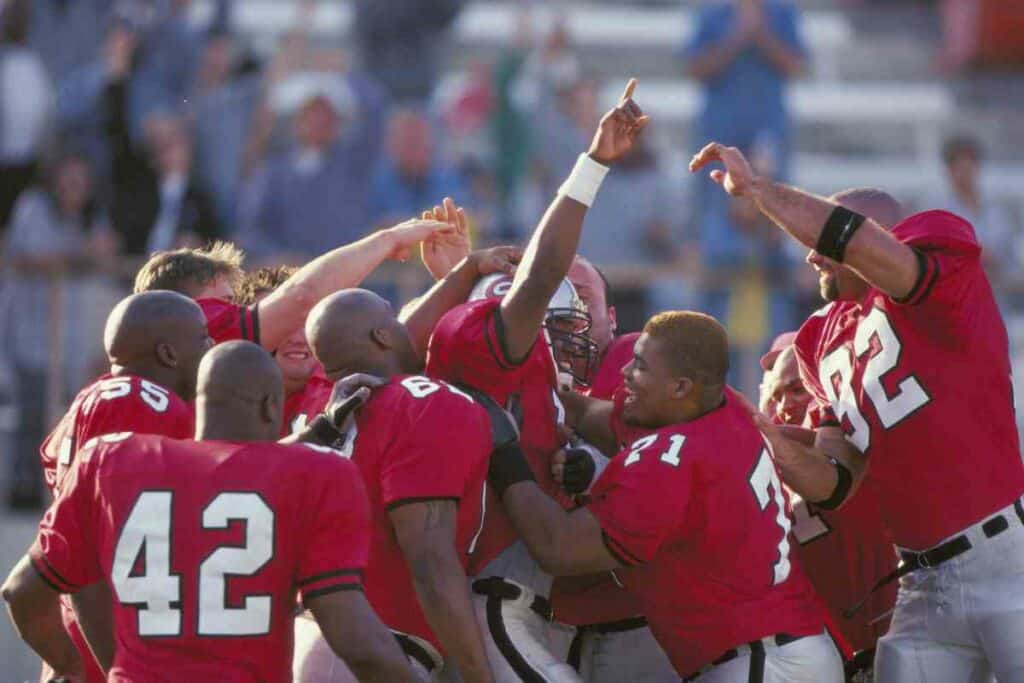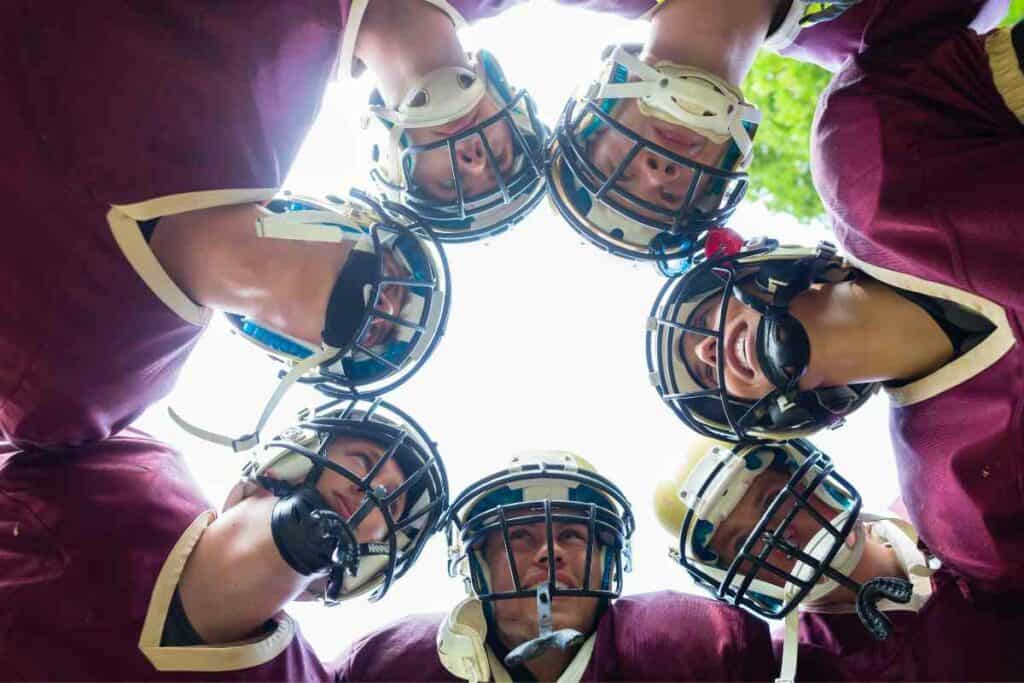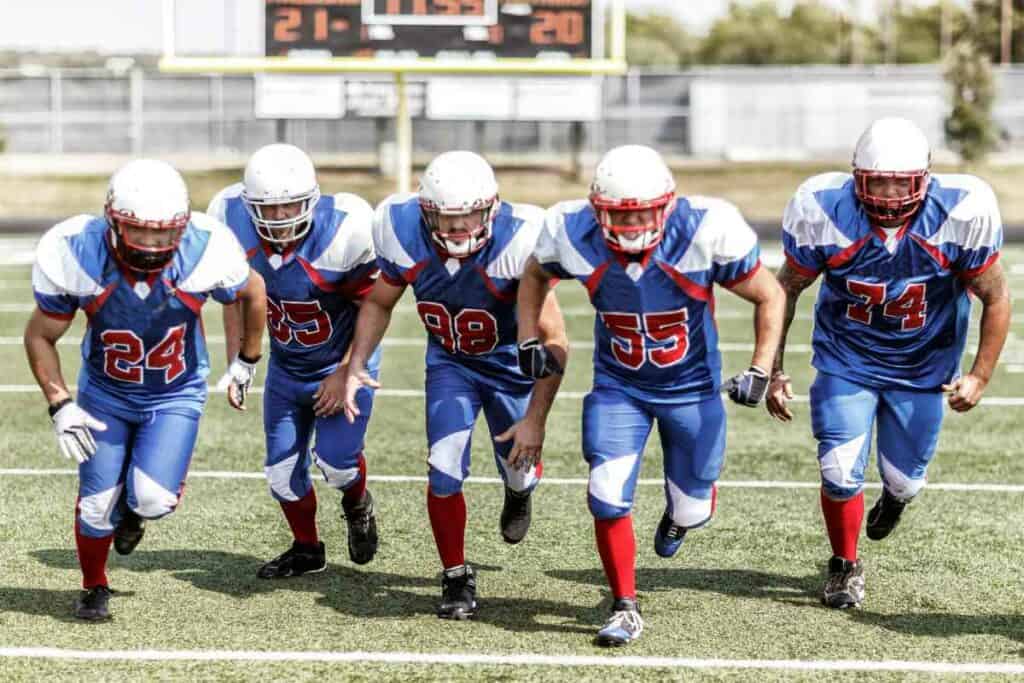How Many Players Do College Football Teams Travel With? Explained.
College football is one of the most popular sports in the United States, with millions of fans tuning in every week to watch their favorite teams compete. While the focus is often on the players on the field, there is a lot of behind-the-scenes work that goes into making each game happen. One of the most important aspects of college football is travel, as teams need to get to their away games in order to compete.
When it comes to traveling for college football, one question that often comes up is how many players do teams typically travel with?

How many players do teams typically travel with?
According to NCAA rules, the travel squad limit for Football Bowl Subdivision (FBS) games is 70 players. This means that teams can bring up to 70 players with them when they travel to away games. However, there is no limit on the number of players that a team can dress for a home game. Additionally, there is no travel squad limit for non-conference games when air travel and/or overnight lodging are not involved.
The answer can vary depending on a number of factors, including the size of the team, the distance they need to travel, and the rules of their conference or division. However, there are some general guidelines that can give us an idea of what to expect.
It’s not just a matter of how many get to go, but HOW they get there. Check out our guide to how college football players travel to away games
Team Travel in College Football
When it comes to college football, team travel is an essential aspect of the game. Teams need to plan their travel to away games, and this involves deciding how many players to take with them. In this section, we’ll take a closer look at how many players college football teams travel with and the different squad and roster limits that apply.
How Many Players Do College Football Teams Travel With?
The number of players that college football teams travel with can vary depending on the team and the game. The travel squad limit for FBS games is 70 players. However, there is no travel squad limit for non-conference contests, including FBS, when air travel and/or overnight lodging are not involved.
Squad Size Limit
The squad size limit refers to the maximum number of players that a team can have on its roster. The NCAA sets the squad size limit at 125 players for FBS teams. However, some teams may choose to have a smaller squad size to provide more playing time for each player.
Roster Limit
The roster limit refers to the maximum number of players that a team can have on its roster during the regular season. The NCAA sets the roster limit at 85 players for FBS teams. However, this limit does not apply to walk-on players who do not receive athletic scholarships.
Active Roster
The active roster refers to the players who are eligible to play in a particular game. For FBS teams, the active roster limit is 85 players. However, teams can choose to have fewer players on their active roster if they wish.
Practice Squad
The practice squad refers to the players who do not travel with the team but are still part of the team’s roster. These players practice with the team during the week and are available for selection if needed. The size of the practice squad can vary depending on the team’s needs.
To summarize, college football teams typically travel with a squad of 70 players for FBS games, and the squad size limit is 125 players. The roster limit is 85 players, and the active roster limit is also 85 players. The size of the practice squad can vary depending on the team’s needs.
| Squad Limit | Roster Limit | Active Roster | Practice Squad |
|---|---|---|---|
| 70 | 125 | 85 | Varies |
Overall, team travel is an essential aspect of college football, and teams need to plan carefully to ensure they have the right number of players for each game.

Logistics of Team Travel
When it comes to college football, travel is a necessary part of the game. Teams travel to away games, and the logistics of getting the entire team, coaches, and staff to the destination can be complicated. Here, we will explore the different modes of transportation that college football teams use to travel to away games.
Transportation
College football teams use various modes of transportation to travel to away games. The most common modes of transportation are air travel and buses. Air travel is the preferred mode of transportation for long-distance trips, while buses are used for shorter trips.
Air Travel
Air travel is the most efficient mode of transportation for college football teams. Teams can travel long distances in a short amount of time, which is especially important for teams that have games on consecutive weekends. Teams can use commercial flights or private planes to travel to away games.
Airports
When traveling by air, teams use commercial airports or private airports. Commercial airports are used for commercial flights, while private airports are used for private planes. Private airports are preferred because they offer more flexibility and privacy compared to commercial airports.
Stadiums
College football teams travel to different stadiums throughout the season. Each stadium has its own unique characteristics, and teams need to be prepared for the different playing conditions at each stadium.
Commercial Flight
Commercial flights are a cost-effective way for college football teams to travel to away games. Teams can book flights in advance to get the best deals on airfare. However, commercial flights can be inconvenient because of the limited flight schedules and the need to go through security checkpoints.
Private Planes
Private planes are the preferred mode of transportation for college football teams because they offer more flexibility and privacy compared to commercial flights. Private planes can be chartered for the entire team, coaches, and staff. This allows teams to travel on their own schedule and avoid the long lines at commercial airports.

Buses
Buses are used for shorter trips, such as traveling to nearby stadiums. Buses are also used to transport the team to and from the airport. Teams can use charter buses or school-owned buses for transportation.
| Mode of Transportation | Advantages | Disadvantages |
|---|---|---|
| Air Travel | Fast | Expensive |
| Private Planes | Flexible | Expensive |
| Commercial Flight | Cost-effective | Inconvenient |
| Buses | Cost-effective | Slow |
In conclusion, college football teams use various modes of transportation to travel to away games. Air travel and buses are the most common modes of transportation. Teams can use commercial flights or private planes to travel by air, while charter buses or school-owned buses are used for shorter trips. Each mode of transportation has its own advantages and disadvantages, and teams need to consider these factors when making travel arrangements.
Costs of Team Travel
When it comes to college football, team travel is an essential aspect of the sport. Teams travel to compete in games, attend training camps, and participate in tournaments. However, the costs of team travel can quickly add up, and it is essential to have a budget in place that takes into account all the expenses involved.
Expense
The expenses involved in team travel include transportation, lodging, meals, equipment, and other miscellaneous costs. The most common mode of transportation for college football teams is by bus or airplane. While bus travel is cheaper, airplane travel is faster and more convenient, especially for long-distance trips.
Lodging is another significant expense for team travel. Teams typically stay in hotels, and the number of rooms required depends on the size of the team. The cost of a hotel room varies depending on the location, time of year, and amenities offered. Some hotels offer discounts to teams, but it is still a significant expense.
Meals are another expense that teams need to consider. Teams typically eat at restaurants or catered events, and the cost can quickly add up. Some teams opt to bring their food, which can save money, but it requires additional planning and preparation.
Equipment is another expense that teams need to consider. Teams need to bring their equipment, such as pads, helmets, and uniforms, to games and tournaments. The cost of equipment varies depending on the quality and quantity required.
Budget
To manage the expenses involved in team travel, teams need to have a budget in place. The budget should take into account all the expenses involved in team travel and allocate funds accordingly. The budget should also include a contingency fund to cover unexpected expenses.
One way to manage team travel expenses is to use a travel management company. These companies specialize in managing team travel and can negotiate discounts on transportation, lodging, and meals. They can also provide support and assistance in case of any travel-related issues.
Another way to manage team travel expenses is to fundraise. Teams can raise funds through various means, such as selling merchandise, hosting events, or soliciting donations. Fundraising can help offset the costs of team travel and ensure that the team can participate in games and tournaments without financial strain.
In conclusion, team travel is a significant expense for college football teams, and it is essential to have a budget in place that takes into account all the expenses involved. By managing expenses and using cost-saving strategies, teams can ensure that they can participate in games and tournaments without financial strain.
Conference Contests and Away Games

When it comes to college football, teams often have to travel long distances for away games. The number of players that travel with the team can vary depending on the type of game and the conference the team belongs to.
Conference
Each conference has its own rules regarding the number of players that can travel for away games. The travel squad limit for FBS games is generally 70 players, but there is no limit for non-conference contests when air travel and/or overnight lodging are not involved.
Power Five
The Power Five conferences (ACC, Big Ten, Big 12, Pac-12, and SEC) are the most competitive conferences in college football. These conferences often require teams to travel long distances for away games. For example, according to a Reddit analysis of the 2021 Football Bowl Subdivision schedule, 41 teams are averaging trips of at least 600 miles for away and neutral site games.
SEC
The SEC is one of the most competitive conferences in college football. According to SEC rules, teams can travel with up to 70 players for away games. However, there is no limit on the number of players that can dress for a home football game according to NCAA rules.
ACC
The ACC is another competitive conference in college football. According to ACC rules, teams can travel with up to 72 players for away games. However, the conference allows teams to travel with up to 76 players for games that require air travel.
Big Ten
The Big Ten is one of the oldest and most prestigious conferences in college football. According to Big Ten rules, teams can travel with up to 74 players for away games. However, there is no limit on the number of players that can dress for a home football game according to NCAA rules.
Pac-12
The Pac-12 is a conference that includes schools from the western United States. According to Pac-12 rules, teams can travel with up to 76 players for away games. However, the conference allows teams to travel with up to 80 players for games that require air travel.
Big 12
The Big 12 is a conference that includes schools from the central United States. According to Big 12 rules, teams can travel with up to 70 players for away games. However, there is no limit on the number of players that can dress for a home football game according to NCAA rules.
In summary, the number of players that college football teams travel with for away games can vary depending on the conference and the type of game. While most conferences have a travel squad limit of 70 players for FBS games, some conferences allow teams to travel with more players for games that require air travel.

NCAA Regulations on Team Travel
When it comes to college football, team travel is an essential aspect of the sport. NCAA regulations govern the number of players that can travel with a team, as well as the eligibility and scholarship requirements for student-athletes. In this section, we will explore the NCAA regulations on team travel, including eligibility, scholarship, FBS, FCS, Division I, and student-athletes.
NCAA
The NCAA sets the guidelines for all college sports, including football. According to NCAA regulations, teams are allowed to travel with 70 players for regular-season games and 80 players for bowl games. However, individual conferences may have their own rules that differ from the NCAA guidelines.
Eligibility
To be eligible to travel with the team, a player must meet certain criteria. First and foremost, the player must be eligible to play in the game. Additionally, the player must be in good academic standing and meet all NCAA eligibility requirements.
Scholarship
Scholarship players are given priority when it comes to team travel. However, walk-on players may also be allowed to travel with the team if there are open spots. The number of scholarship players that can travel with the team varies by division.
FBS
In the Football Bowl Subdivision (FBS), teams are allowed to travel with 70 players for regular-season games and 80 players for bowl games. However, teams may also travel with additional players if they are injured or suspended.
FCS
In the Football Championship Subdivision (FCS), teams are allowed to travel with 60 players for regular-season games and 65 players for playoff games.
Division I
In Division I football, teams are allowed to travel with 70 players for regular-season games and 80 players for bowl games. However, individual conferences may have their own rules that differ from the NCAA guidelines.
Student-Athletes
Team travel can be a significant time commitment for student-athletes, as they may miss classes and other academic obligations. To help mitigate this, the NCAA requires teams to provide academic support for student-athletes while they are on the road. Additionally, teams are required to follow specific guidelines for travel expenses, including transportation, lodging, and meals.
In summary, NCAA regulations govern the number of players that can travel with a team, as well as the eligibility and scholarship requirements for student-athletes. These regulations vary by division and conference, and teams must provide academic support for student-athletes while they are on the road.

Coaching and Operations Management
When it comes to traveling for away games in college football, coaching and operations management play a crucial role in determining the number of players that a team travels with. Let’s take a closer look at the responsibilities of coaches and operations managers in this regard.
Coaches
Coaches are responsible for deciding which players will travel with the team for away games. This decision is based on a number of factors, including the player’s position, performance, and injury status. Generally, coaches aim to travel with as many players as possible to ensure that they have enough depth to cover any injuries or unexpected situations during the game.
However, there are some restrictions on the number of players that a team can tscsravel with. According to NCAA rules, football teams are limited to 70 players for away games. This includes all players who are eligible to play, as well as any redshirting players who are not eligible to play but are still part of the team.
Operations Manager
Operations managers are responsible for managing the logistics of traveling with a football team. This includes arranging transportation, booking hotels, and ensuring that all necessary equipment and supplies are available for the team.
When it comes to determining the number of players that a team will travel with, operations managers work closely with coaches to ensure that all logistical requirements are met. This may involve coordinating with airlines or bus companies to ensure that there is enough space for all players and equipment.
To get a better understanding of how many players college football teams travel with, let’s take a look at a table of some of the top programs in the country:
| Team | Number of Players |
|---|---|
| Alabama | 70 |
| Clemson | 70 |
| Ohio State | 70 |
| Oklahoma | 70 |
| Georgia | 70 |
| LSU | 70 |
| Florida | 70 |
| Notre Dame | 70 |
| Texas | 70 |
As we can see, all of these top programs travel with the maximum number of players allowed by NCAA rules. This ensures that they have enough depth to cover any injuries or unexpected situations during the game.
Advantages of Team Travel
When it comes to college football, team travel is an essential aspect of the sport. While it may seem like a hassle to travel with a large group of players, coaches, and staff, there are many advantages to doing so. In this section, we will explore some of the benefits of team travel, including time, camaraderie, and study.

Time
One of the most significant advantages of team travel is that it allows players to focus entirely on the game. When traveling together, players don’t have to worry about things like transportation, lodging, or meals. Instead, they can use that time to rest, recover, and prepare for the game ahead.
Moreover, team travel also minimizes distractions that can negatively impact players’ performance. For instance, players who travel separately may arrive at different times, which can cause confusion and disrupt team dynamics. On the other hand, when traveling together, players can arrive at the same time, stay in the same hotel, and have a consistent routine that helps them stay focused.
Camaraderie
Another significant advantage of team travel is that it fosters camaraderie among players. When traveling together, players have the opportunity to bond and build relationships that can translate into better teamwork on the field. This can be especially beneficial for new players who may not have had the chance to get to know their teammates well.
Moreover, team travel also helps players develop a sense of pride and belonging. When players travel together, they represent their school and their team, which can create a sense of unity and purpose that can motivate them to perform at their best.
Study
Finally, team travel also provides players with an opportunity to study and prepare for the game. When traveling together, players can review game film, analyze opponents’ strategies, and discuss tactics with coaches and teammates. This can be especially beneficial for players who may not have had the chance to do so during regular practice or game weeks.
Moreover, team travel also allows players to learn more about the history and traditions of their school and their opponents. This can help players develop a deeper understanding of the sport and a greater appreciation for the community that supports them.
| Advantages of Team Travel |
|---|
| Allows players to focus on the game |
| Minimizes distractions |
| Fosters camaraderie among players |
| Builds a sense of pride and belonging |
| Provides an opportunity to study and prepare for the game |
In conclusion, team travel is an essential aspect of college football that provides many advantages to players. From allowing players to focus on the game to fostering camaraderie and providing an opportunity to study and prepare, team travel is a vital part of the sport that helps players perform at their best.
Food and Lodging

When college football teams travel to away games, they need to ensure that their players are well-fed and rested. Food and lodging are two essential aspects of travel that teams need to take care of.
Most college football teams stay in hotels when they travel to away games. According to an article by The Ledger, some college football teams also stay in hotels before home games. The article states that college football teams spent $4.91 million on home-game hotel rooms in 2018.
When it comes to food, college football teams usually eat at restaurants or catered meals. Some teams may also bring their own food, especially if they have dietary restrictions or preferences. According to an article by The Metamorphosis, college football players can expect to travel for at least five games a season. This means that teams need to plan their meals for multiple games and ensure that their players are getting the nutrition they need to perform at their best.
To get a better idea of how much food and lodging can cost for college football teams, we can look at the invoices for the team’s first October home game of the 2019 season, as reported by Richmond. The article states that the 12 schools spent a combined total of $328,144.19 on hotels for their first October home game.
In conclusion, food and lodging are two essential aspects of travel that college football teams need to take care of. Teams usually stay in hotels and eat at restaurants or catered meals when they travel to away games. The cost of food and lodging can add up quickly, especially if teams need to travel for multiple games throughout the season.
Conclusion
In conclusion, college football teams typically travel with around 70-80 players, including starters, backups, and special teams players. This number may vary depending on the team’s budget, the size of the coaching staff, and the level of competition.
Recruiting is a crucial aspect of college football, and having a large team can help attract top recruits. However, it also means that coaches must manage a larger roster and allocate playing time accordingly.
While football is the main focus of many college athletic programs, basketball and other sports also require travel. These teams may travel with fewer players due to the smaller roster sizes.
It’s worth noting that college football players are not paid, despite the significant revenue generated by the sport. This has led to ongoing debates about compensation and the role of college athletics in the larger sports industry.
Overall, the number of players that college football teams travel with is a complex issue that depends on a variety of factors. However, it’s clear that having a well-managed roster can be a key factor in a team’s success on the field and in recruiting top talent.
| Entity | Relevant Information |
|---|---|
| Recruiting | Large rosters can help attract top recruits |
| Football and basketball | Both sports require travel, but basketball rosters are typically smaller |
| NFL | Many college football players aspire to play professionally in the NFL |
| Revenue | College football generates significant revenue, but players are not compensated |
